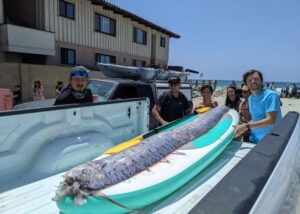If you see a rainbow, it means you’re in for some good luck, but if you see a deep-sea fish, this means that something tragic is about to happen. Let’s have a look at ancient beliefs and what they might mean in real life.

Oarfish: The Doomsday Fish
In August 2020, people in California started their day just like any other. It was sunny, so they decided to soak in the sun at the beach. They were snorkeling and kayaking when one of them spotted something out of the ordinary: a “doomsday fish.” The creature was 12 feet long. It’s known as an oarfish, and only about 20 of them have washed up in California since 1901.
Oarfish and Doomsday Associations
Oarfishes live in obscure parts of the ocean, but why are they linked to doomsday? Japanese folklore says they are harbingers of disaster. These creatures were once thought to be sea serpents and are known as the messenger of the beautiful palace at the bottom of the ocean. The thing is, they only left the beautiful palace to warn humans about a disaster. That’s why they’re mainly known as bad omens, and when you see one, you can expect to see a tsunami or an earthquake right after. Even oceanographers confirm that this is a famous association.
The Oarfish Incident in 2020

Now, here’s where it gets weird. The oarfish washed up near San Diego shores on the 10th of August, and then, on the 12th of August, a magnitude 4.4 earthquake hit Los Angeles. That’s not the first time this has happened. In 2011, in Japan, about 20 oarfish were found stranded on the beaches and coastlines of Tōhoku. Right after that, a magnitude 9 earthquake and tsunami hit the city. Something similar happened in the Philippines on February 8th, 2017. An oarfish was seen, and 2 days later, a magnitude 6.7 earthquake struck the city and its nearby provinces.
Statistical Analysis of the Events
Sure, there’s no way to prove both events are connected. The Seismological Society of America is adamant in saying that this is pure superstition. A recent study analyzed the coincidences and concluded that this association is statistically untrue.
Animal Behavior Before Disasters
Can we say this happened literally out of the blue? Humans have historically noticed animals acting strange right before natural disasters: earthquakes, floods, even tsunamis. It’s like animals can sense something we can’t. In fact, there’s a lot of science to back it up. Studies show that animals can detect subtle environmental changes, like shifts in the Earth’s electromagnetic field or infrasonic sounds—things humans wouldn’t notice.
The 2004 Indonesian Tsunami
This happens because most animals have a wider hearing range than humans and have extra-sensitive senses that help them detect gases emitted from the earth. This theory became famous after the tragic tsunami that destroyed several cities and villages in Indonesia back in 2004. Most man-made warning systems shut down and didn’t serve their role of warning humans about the disaster. Sensors were out of action due to maintenance, while other coastal areas simply didn’t have any tsunami warning systems. Terrible timing, I know. Still, minutes and hours before the 30-foot wave hit the city, some animals sensed the danger and fled. Eyewitnesses say that elephants ran for higher ground, flamingos abandoned their low nesting areas, and dogs refused to go outdoors. A local reported that he saw a herd of buffalo turning their ears toward the sea and then stampeding to the top of a hill. A lot of the people that survived the tsunami used animals as their warning systems.

Historical Accounts of Animal Behavior
Now, this is not the first time humans have relied on animals to save their lives. The first official account of this happening dates back to 373 BCE. I wasn’t around then, but the Greek historian Thucydides reports how the local population saw rats, weasels, and snakes running from the town before a massive earthquake hit.
Scientific Studies on Animal Senses
So, what exactly is it that animals can sense that humans can’t? To find out, scientists put bio-logging tags on cows, sheep, and dogs living in Italy. For about half a year, they tracked the animals. During this time, official statistics recorded over 18,000 quakes in the region. The most shocking information was that animals began to change their behavior up to 20 hours before an earthquake.
Positive Holes and Groundwater Changes
Before an earthquake, something called “positive holes” happens. It’s an electric charge that flows from the crust up to the surface of the Earth. They can change the air molecules above where they appear, and animals can pick up on them. There’s also evidence that animals might sense changes in groundwater before earthquakes. The stress in fault lines can release radon gas, which could alter the chemistry of groundwater. Animals that rely on it might detect these changes and react. Birds are also super sensitive to shifts in the Earth’s magnetic field, which can change just before a quake.
Research Near Mount Etna
Another research happened near Mount Etna, located in Sicily, Italy. It’s one of the most active volcanoes on the planet. In 2002, a massive eruption wiped out a ski lift, two hotels, and a series of shops located near Etna. Over the past years, a group of researchers decided to track goats living next to Etna. Their big “aha” moment came in 2012 when the goats started to act erratically six hours before Etna started to spew lava. These researchers were able to retrospectively predict around seven disasters over the course of two years—all thanks to these goats.
Evacuation Migration of Birds
Back in 2014, a group of scientists studying golden-winged warblers in Tennessee noticed something odd. The birds had taken a detour from their customary breeding grounds. These little birds flew 435 miles from the Cumberland Mountains, where they had just arrived after flying over 3,000 miles from South America. Right after the birds left, a series of more than 80 tornadoes struck the area, causing over a billion dollars in damage. What these birds did is something scientists call an evacuation migration. They sensed the tornadoes coming from over 250 miles away.
Understanding Infrasound
Infrasound is a big disaster giveaway. Storms and tornadoes make very strong infrasounds that can travel thousands of miles from the storm. Now, infrasounds are low-range frequencies, anything ranging below 20 Hz. With our normal set of human ears, we would never hear this. We have an average hearing that ranges from 20 Hz to 20,000 Hz. That means you can hear something like a very, very low bass note or as loud as the buzzing of a mosquito right next to your ear. An elephant’s hearing range can reach below 20 Hz. This would make elephants experts at detecting disasters. Scientists also think that detecting infrasound is what helps birds dodge storms when they must cross the ocean. The Pacific Ocean is known to not be passive at all. Although courageous humans venture to cross it, they’re usually met with severe storms and conditions that their satellite instruments sometimes can’t detect.
Ongoing Research and Skepticism
Meanwhile, there’s an ongoing project from France’s National Museum of Natural History that is tracking more than 100 birds on their annual crossing over the Pacific. With the help of the International Space Station, they’re trying to understand how these little creatures respond to natural hazards en route. But not everyone’s convinced. Some scientists argue that while animals might be sensitive to environmental shifts, predicting disasters based on their behavior is too risky. The U.S. Geological Survey has pointed out that many reported cases of unusual animal behavior before disasters are anecdotal—meaning stories and reports—and large-scale studies have yet to prove a direct link.
Human Awareness of Disasters
Although humans don’t have these super capabilities of predicting disasters, we have some things that might help us notice them. The next time you’re in a place where lightning is going to hit, your hair will give a sign. If it stands on end, this means that lightning is aimed toward your beautiful person and is about to hit you—so run, find shelter, get inside a house. That’s the best you can do in a situation like this.
That’s it for today! So hey, if you pacified your curiosity, Explore more Amazing Facts and stay on the mudassirmirza.online!
- The Science Behind Feeling Like You’re Being Watched
- The Full Story of Unicorns: Yes, They Were Real
Read our previous article: Unexplored Places We Are Still Not Sure Really Exist
